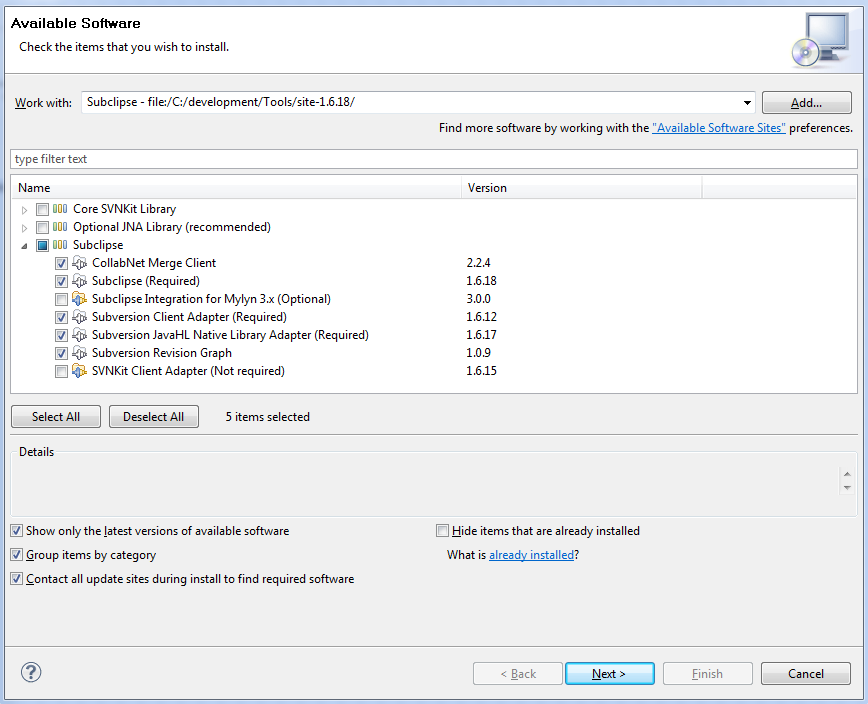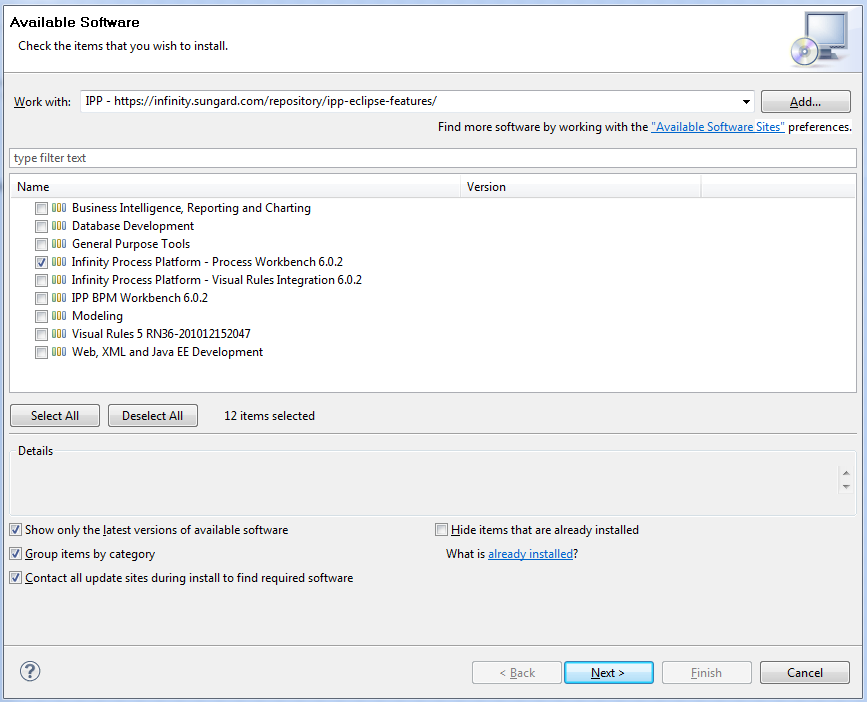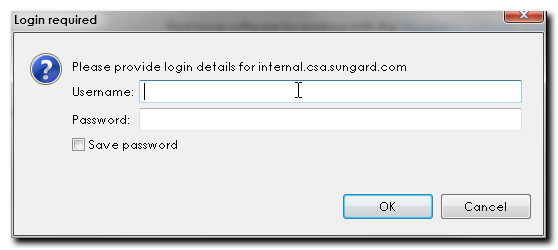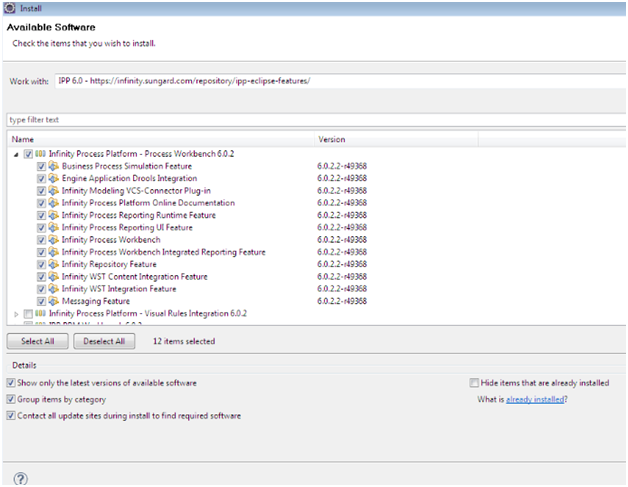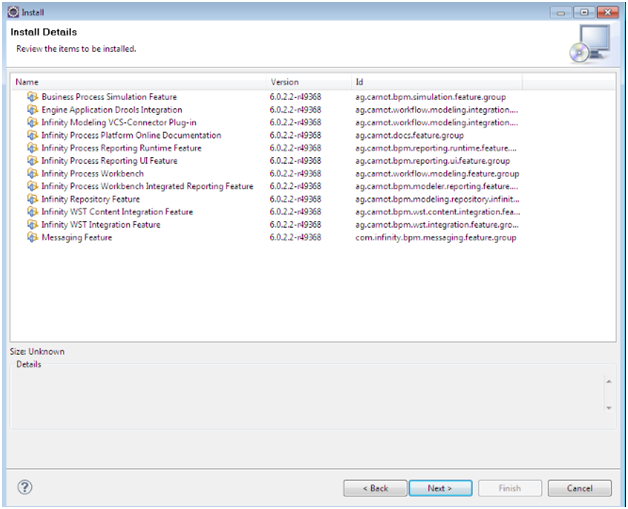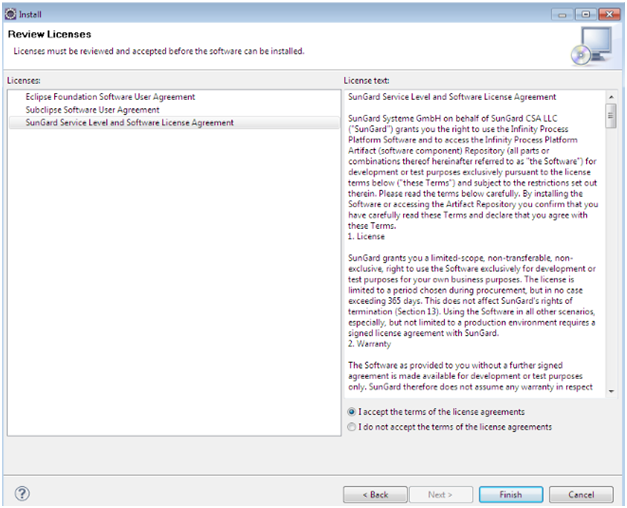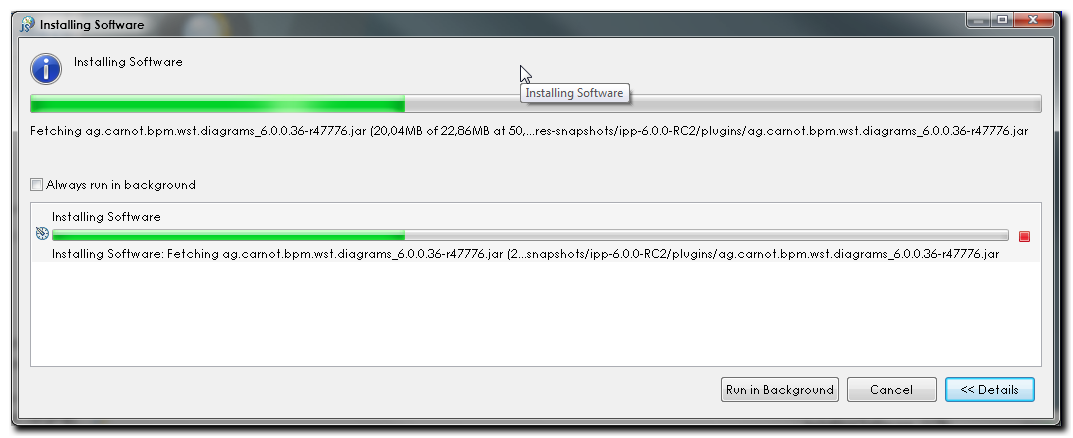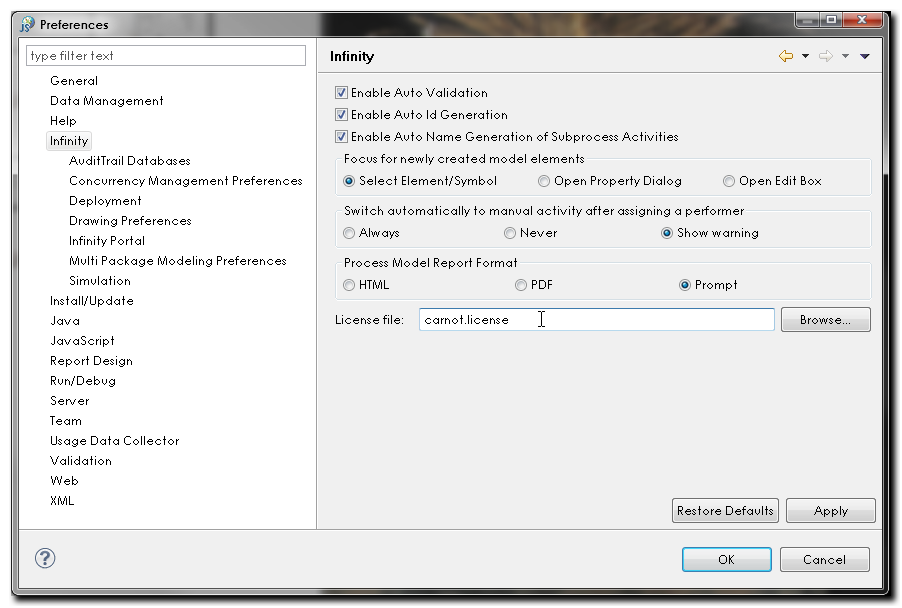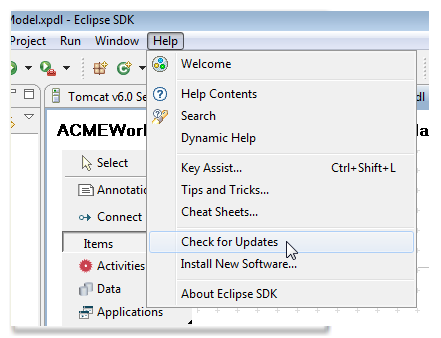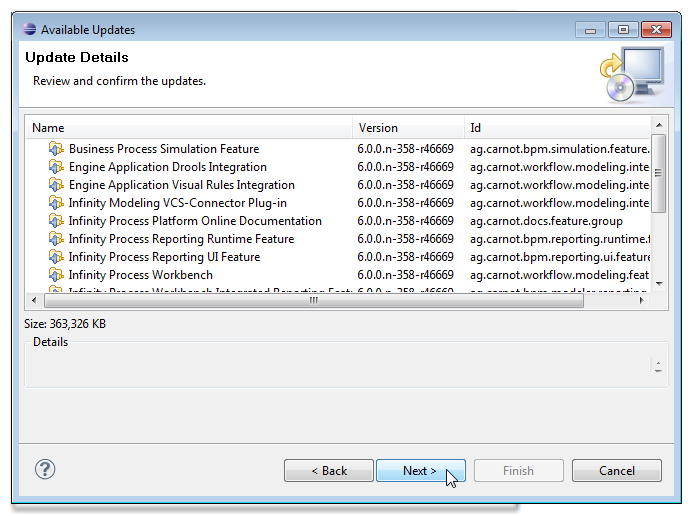Notice: this Wiki will be going read only early in 2024 and edits will no longer be possible. Please see: https://gitlab.eclipse.org/eclipsefdn/helpdesk/-/wikis/Wiki-shutdown-plan for the plan.
Difference between revisions of "Stardust/Knowledge Base/Getting Started/Installation"
m |
m (STP/Stardust/KnowledgeBase/GettingStarted/Installation moved to Stardust/Knowledge Base/Getting Started/Installation: Stardust is not STP) |
(No difference)
| |
Revision as of 23:52, 6 February 2012
While we are packaging up Stardust for Eclipse, you can get free access to Infinity Process Platform from SunGard. This is the source product that the Stardust contribution originates from. Please follow instructions here to get access.
Contents
Introduction
To get started you need to install an Eclipse Helios including the required dependencies and the Process Workbench Eclipse features. These features includes the process modeller, the rapid application development (RAD) environment and the report designer extension.
After installing Eclipse and dependencies as described in the followoing section "Eclipse Installation" you have several options to add the Processworbench Eclipse features to it:
- Online Eclipse update site - This is a good choice if you:
- don't know what to choose
- have a reliable, fast internet connection
- only want to install on a single PC / environment
- want to check for updates frequently and intend to update to the latest and greatest version frequently
- Local Eclipse update site (offline) - This is a good choice if you:
- have a not so fast and reliable internet connection
- have an internet connection with high latency / response times
- want to install on multiple PCs / environments
- are going to check for updates less frequently or not via the built-in update mechanism
- may not always upgrade to the latest patch release
- Install features as dropins (offline) - This is a good choice if you:
- know what you are doing
- are sure that you have the right Eclipse version with all required dependencies installed
- are familiar enough with the eclipse plug-in mechanism and know how to install missing dependencies if needed
- rather perform some steps in the file system than walk through the dialogs of the (local) Eclipse update site installation
- want to separate the new features from you Eclipse installation on file system level
- want to automate the installation for multiple environments
Eclipse Installation
The right Eclipse Version
The Process Workbench is based on the Eclipse Platform and consists of the combination of the basic Eclipse platform and a number of plug-ins. Currently only Eclipse Helios Service Release 2 (Eclipse 3.6 SR2, build 20110218-0911) is supported. Please make sure to download the appropriate version for your operating system. It’s strongly recommended to download the bundle Eclipse IDE for Java and Report Developers here to avoid having to install additional missing plug-ins at a later point.
After downloading, install Eclipse by unzipping it into a target folder of your choice. Start the Eclipse application. When the Eclipse IDE opens for the first time you are presented with a Welcome screen, which you may close.
The Subclipe Plug-ins
The Collaborative Modeling feature requires Subclipse 1.6.17. The fastest and most stable way to install Subclipse plug-ins is to download the local update site from here, extract it to your local drive and install it into Eclipse from there.
- In your Eclipse Go to: Help > Install New Software...
- Add a new local update site named "Subclipse" pointing to the location to which you have previously extracted the Subclipse zip archive
- Slect the newly created local update site "Subclipse" in the "Work with" selection
- Select check the plug-ins as shown in the screenshot below
- Confirm all follow up screens
- Restart Eclipse after installation
Process Workbench Eclipse Feature Installation
Online Eclipse Update Site
After the installation of Eclipse and the Subclipse plug-ins the Processworkbench Eclipse features can be installed.This section describes how to do this using the online Eclipse update site.
(See the introduction for other options).
- Go to: Help > Install New Software...
- Add a new remote update site named "IPP" pointing to https://infinity.sungard.com/repository/ipp-eclipse-features/
- Select the new IPP remote update site and when asked for a login type in the credentials (e-mail/password) you used when registering at the Infinity Storefront
- Select the checkbox Infinity Process Platform - Process Workbench 6.x.x
- Confirm all possible follow up screens
- Restart Eclipse after the installation has completed.
Note: Select Infinity Process Platform Visual Rules Integration only if this functionality is required and Visual Rules 5 RN36-201012152047 plug-in bundle has been installed up-front. If Subclipse plug-ins have not been installed already, please unselect Infinity Modeling VCS-Connector plug-in.
Screenshot: Login screen
Screenshot: Selected plug-ins screen
Screenshot: Review screen
Screenshot: License Agreement screen
Screenshot: Installation progress screen
Once installation is finished, a dialog appears suggesting to restart, which you should do. The Process Workbench requires a license file to be present. To load it, select Preferences and go to the Infinity section. Type the path to the license file or click Browse to locate it. Click Apply or OK.
Turn to the integrated documentation or to the online documentation to learn more about the Process Workbench. The documentation for the Process Workbench can be found under the Help > Help Contents menu item and then selecting the chapter for Infinity Process Platform Documentation.
Enjoy using Infinity Process Workbench until you can use it as Stardust as an even more integral part of the Eclipse project!
Local Eclipse Update Site (offline)
For one of the reasons mentioned in the introduction you may perfer to download the complete update site so you can use it as a local Eclipse update and install the Process Workbench Eclipse Features offline, possibly to multiple environments. The zipped complete Eclipse update site can be downloaded from the repository
https://infinity.sungard.com/repository/ipp-eclipse-features/ipp-6.0.3/offlineSite.zip. (Replace the version number in the URL according to your needs)
Download the zip file and extract it to your local disk. The installation of the right Eclipse version and of Subclipse as described in the section "Eclipse Installation" is still a pre-condition.
- Go to Help > Install New Software...
- Add a new local update site "IPP" pointing to the location to which you have extracted the offlineSite.zip archive
- Select the created local update site and select Infinity Process Platform - Process Workbench 6.x.x
- Confirm all possible follow up screens
- Restart Eclipse after installation
(see section "Online Eclipse Update Site" for more details)
Install Features as Dropins (offline)
Please refer to the Eclipse Platform Plug-in Developer Guide's section "The dropins folder and supported file layouts".
Remember start Eclipse using the parameter -clean after making modifications to the dropins folder.
Retrieving Artifacts from the Maven Repository
If you just want to get started quickly, create a process model and possibly use the rapid application development (RAD) environment to execute it then you don't need this. In that case please continue with the "Where to go from here" section.
Additionally to the Process Workbench Eclipse features the following artifacts and scripts can be found in the Maven repository:
- Maven Archetypes - Generate Maven projects for different engine runtime, reporting runtime and client environments as well as for the administrative command line tools
- Runtime artifacts- Used by Maven, Ivy or othe rbuild tools to build runtime environments (WARs / EARs)
- Client scripts- Used by Maven or Ivy to generate client evironments for the commandline tools
- Spring configuration files - Used by Maven, Ivy or other build tools to build Spring client and runtime environments
- Web artifacts like deployable archives and configuration snippets
- Infinity Scan component
The Maven archetype is defined in the archetype-catalog.xml.
The other artifacts can be download directly from the repository location https://infinity.sungard.com/repository/ipp-libs/com/infinity/bpm/ipp-tools
or using Ivy integrated Ant tasks as described here.
Where to go from here
We suggest to have look at the training videos and the Tutorial in the product documentation.
Also go to the Stardust Knowledge Base to find How-Tos, API Cookbook, articles, advanced tutorials and more material that will help you to get your project running quickly.
Upgrading Installed Features
The installed Process Workbench Eclipse Features can be upgrade to a new version or downgraded to previously installed version. To upgrade your installed features to a later version provided via an update site perform the following steps:
- In the main menu, select Help > Check for Updates.
- The Available Updates dialog opens. Select the updates you like to install. In the Version column, the newest version to update to is displayed.
- Review and confirm your selected updates and click Next.
- Accept the license and select Finish.
- Restart Eclipse.
If upgrading to a new version in an already configured environment you also need to perform the necessary steps to upgrade your Web project and process model(s) as described in the product documentation chapter Upgrading to Later Versions.

